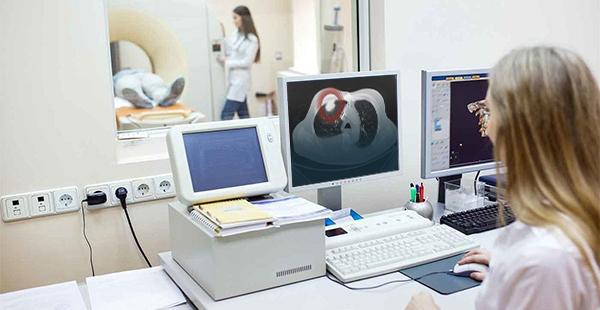01. Imaging Scans & Mesothelioma
How Are Imaging Scans Used to Help Diagnose Mesothelioma?
Imaging scans are often the first step in the process of diagnosing mesothelioma, a type of cancer caused by asbestos exposure. Doctors may use a variety of imaging scans to help diagnose mesothelioma.
For example, a doctor may initially order a chest X-ray to look for any lung or chest abnormalities. The mesothelioma doctor may use a Positron Emission Tomography (PET) scan later in the process to help determine the patient’s stage of mesothelioma.
Depending on the type of scan, doctors can get information to:
- Estimate how the treatment is affecting the tumors
- Help understand how much cancer there is or how far it has spread
- Monitor a patient for cancer recurrence
- Show possible suspicious tissues or areas that might be cancer
Doctors may recommend several different imaging scans. While each has advantages and limitations, imaging scans alone do not provide enough information to allow a doctor to diagnose mesothelioma. Instead, doctors may recommend a blood test or biopsy. Testing a biopsy sample is the only definitive way to diagnose mesothelioma.
Resources for Mesothelioma Patients
02. X-Rays
X-Rays: An Early Step in Mesothelioma Diagnosis
A doctor may order an X-ray early in the diagnostic process for mesothelioma. An X-ray sends electromagnetic radiation through a person’s body to capture images of structures inside the body.
X-rays are common medical imaging tests. Doctors often use X-rays as first-level diagnostic tools to see inside the patient’s body and discover any abnormalities.
X-rays usually take no longer than 5 – 10 minutes. However, some specific X-ray procedures, such as those involving contrast dye, may take longer.
Doctors use X-rays to help rule out other illnesses. For example, patients with difficulty breathing or chest pain may have a chest X-ray. The chest X-ray can help narrow down the cause of the patient’s symptoms from several conditions, including pneumonia, emphysema and heart issues.
Can You See Mesothelioma on an X-Ray?
An X-ray can help a doctor detect abnormalities in many parts of the body. Those abnormalities appear white on the X-ray, and healthy tissues appear black.
For instance, a chest X-ray can help a doctor detect tumors or excessive fluid buildup around the lungs. This excess fluid is called pleural effusion, a common symptom of pleural mesothelioma.
While a doctor can see the abnormalities, they will not be able to diagnose them as mesothelioma. The only way to diagnose mesothelioma is by testing a biopsy sample.
Chest X-Rays (CXR)
In cases of pleural mesothelioma, chest X-rays are the most common type of X-ray. Doctors order chest X-rays to look for abnormalities in the chest and around the lungs. Some common things a doctor looks for in a mesothelioma chest X-ray include:
- Pleural effusion or pleural thickening
- Loss of space in the chest cavity
- Lung compression
These findings may suggest additional tests are needed. The patient’s doctor can explain more about chest X-rays for pleural mesothelioma.
03. CT Scans
Computed Tomography (CT) Scans
A CT scan, sometimes called a CAT scan, can also help doctors diagnose mesothelioma. Like X-rays, CT scans are commonly used to view organs, tissues and tumors. Instead of a single image, CT scans provide a series of images from different angles.
CT scans use multiple X-rays that doctors can look at individually or stack on top of each other to create a 3D model. Complete results from a CT scan can take 24 hours. Doctors may use a CT scan for patients with signs of pericardial mesothelioma.
Some CT scans use a dye, or contrast material, to enhance the captured images. The contrast material makes it easier for doctors to visualize specific organs or tissues.
CT scans provide clear, specific information on the imaged tissues. They are also relatively fast and capable of imaging small or large areas within a single session. As such, CT scans are useful in determining the stage of mesothelioma.
What Does Mesothelioma Look Like on a CT Scan?
A CT scan of pleural mesothelioma may show tumors along the lining around the lung (the pleura). The CT scan may also show pleural thickening or effusion, which are both consistent with a pleural mesothelioma diagnosis.
X-rays and CT scans both provide images of structures inside the body. However, CT scans show greater detail and allow the doctor to see it in 3D. CT scans cannot diagnose mesothelioma, but they may help lead a doctor to that diagnosis.
For example, peritoneal mesothelioma CT scans may show tumors within the abdominal cavity lining. A CT scan may also reveal fluid accumulation within the abdomen (ascites) or tumors on the liver or colon.
After diagnosis, studying a CT scan can also help doctors determine the best mesothelioma treatment, such as whether surgery is needed or possible.
04. MRI Scans
Magnetic Resonance Imaging (MRI) Scans
An MRI scan can help diagnose mesothelioma by creating detailed images of structures inside the body. An MRI may show organs, bones, blood vessels and soft tissues like muscle or tumors. Doctors use these images to evaluate whether further tests, such as a biopsy, are needed.
MRI scans use radio waves and a strong magnetic field. It’s a painless, non-invasive procedure that does not use radiation. Some MRI scans may use an injectable contrast dye to help make tissues appear more clearly in the images.
Depending on the area being scanned, an MRI can take anywhere from 15 minutes to an hour or longer. The doctor may be able to tell the patient how long they expect it to take based on the images needed.
An MRI scan effectively highlights abnormalities in the body, including tumors and cysts. MRI scans may also show doctors how far the cancer has spread and if surgery for removal is possible.
Can MRIs Detect Mesothelioma?
While MRIs can help detect mesothelioma, they are not a primary imaging tool for diagnosis. MRIs provide detailed images of soft tissues and can identify how far the tumor has spread. Other imaging methods, like CT scans, are more commonly used to support an initial mesothelioma diagnosis.
Doctors have found MRIs to be helpful for planning surgery on pleural mesothelioma tumors. They also help doctors figure out the stage of the disease and manage treatment for malignant pleural mesothelioma.
05. PET Scans
Positron Emission Tomography (PET) Scans
PET scans show tissues and cells that use a lot of energy, like cancer cells. For this type of imaging scan, the patient receives radioactive sugar. Cells that use a lot of energy absorb more sugar than other cells. Thus, cancer cells appear brighter compared to surrounding tissues.
A PET scan cannot show if a tumor is mesothelioma, but it does show abnormal tissue. Doctors can use that information to help determine:
- The size, location and growth speed of the tumor
- Whether thickening found in a CT scan is likely to be from cancer or scar tissue
- If the cancer has spread, or metastasized, to other parts of the body, like lymph nodes
Doctors may also use PET scans for mesothelioma patients to measure the efficacy of treatment. For instance, doctors may use a PET scan after or during a patient’s course of chemotherapy to look for tumor progression.
PET Scans vs. CT Scans
PET scans and CT scans are collected the same way, using a rotating cylinder that gathers pictures from all angles. These scans differ mainly in the information they provide.
- CT scans create still images of tissues and bones. PET scans show which tissues are using a lot of energy.
- PET scans use radioactive sugar, and CT scans do not.
- PET scans generally take longer than CT scans.
06. Ultrasounds
Ultrasounds
Ultrasounds do not use radiation like X-rays, CT scans or PET scans. Instead, they use sound waves to travel through a person’s body and bounce back when they hit organs. The sound waves bounce off structures at different rates, allowing the machine to create images.
Ultrasound waves cannot transmit properly through air, which is found in the lungs and abdominal organs. This means ultrasound produces inferior images of structures in the chest and abdomen.
However, a doctor might opt for an ultrasound in certain instances, such as:
- If a patient presents symptoms or shows abnormalities that suggest testicular mesothelioma
- If there is fluid buildup around the heart (this type of ultrasound is known as an echocardiogram), which may be consistent with pericardial mesothelioma
For mesothelioma, doctors may use an ultrasound to pinpoint where a tumor or excess fluid, like a pleural effusion, is in the body. They may also use ultrasound to help guide a needle during certain procedures, like a thoracentesis or biopsy.
07. Image Testing by Type
Mesothelioma Image Testing by Type
Image testing varies by mesothelioma type. Certain imaging tests may work well for some mesothelioma types but not others. For example, doctors commonly use ultrasounds for testicular mesothelioma. However, they typically do not use them for peritoneal mesothelioma.
08. Diagnosis Next Steps
What Are the Next Steps for a Mesothelioma Diagnosis?
Imaging scans can provide doctors with valuable information during and after a mesothelioma diagnosis. For instance, imaging scans may help doctors classify cancer spread or clinical stage using the TNM system. However, imaging alone is not enough to make a definitive diagnosis.
A mesothelioma doctor may use an imaging scan as one of the early tests during diagnosis. After doctors review the imaging scans, they may order other tests, including blood tests and a biopsy.
Testing tissue from a biopsy is the only definitive method of diagnosing mesothelioma. Once the doctor confirms the mesothelioma diagnosis, they will develop the patient’s treatment plan.
Imaging scans may be used again during treatment. These scans can help doctors monitor how well the treatment works, such as looking for any cancer progression after chemotherapy.
09. Common Questions
Common Questions About Mesothelioma Imaging
-
Does asbestos show up on a CT scan?
Asbestos fibers are very small and do not appear on a CT scan. However, the damage and scarring caused by the fibers may show. For example, abnormal tissues in the lungs or the lining around them can show up on the CT scan. If doctors believe the CT scan shows possible signs of an asbestos-related illness, they may order additional tests.
-
Do asbestos fibers show up on an X-ray?
Asbestos fibers are very small and do not appear on an X-ray. However, the damage caused by the fibers may appear. Conditions like pleural or peritoneal effusion, pleural thickening or mesothelioma tumors may be seen. Doctors may order additional tests if they suspect mesothelioma after reviewing an X-ray.
-
What is the best imaging for mesothelioma?
The best imaging for mesothelioma depends on the patient’s needs. Each person has different medical goals and needs that will influence the choice of imaging scan. Doctors select the type of imaging based on what is most important to guiding each patient’s care.
-
Are image scans covered by insurance?
Insurance coverage for imaging scans varies by each carrier and individual insurance plan. Patients should speak with their insurance providers to understand their coverage. Financial assistance may be available if their plans do not cover diagnostic test costs.











